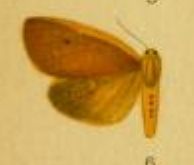Dolgoma is a genus of moths in the family Erebidae. The genus was erected by Frederic Moore in 1878.
Digama insulana is a moth of the family Erebidae described by Rudolf Felder in 1868. It is found in India, Sri Lanka and Vietnam.

Oraesia emarginata is a species of moth of the family Erebidae first described by Johan Christian Fabricius in 1794. It is found in Australia, New Caledonia, Indonesia, New Guinea, Pakistan, the Philippines, India, Sri Lanka, Sulawesi, Taiwan, China, Japan, Korea and Nepal as well as Eritrea, Ethiopia, Kenya, Namibia, Nigeria, South Africa, Tanzania, the Gambia, Uganda, Oman and Yemen.
Ancylolomia chrysographellus, the angled grass moth, is a species of moth in the family Crambidae. It is found on Cyprus and in Kenya, Uganda, Yemen, India, Pakistan, Sri Lanka, Myanmar, China, Korea, Japan, Taiwan, the Philippines and Indonesia.

Phazaca theclata is a moth of the family Uraniidae. It was first described by Achille Guenée in 1858. It is known from Africa south of the Sahara, from Saudi Arabia, as well as from India, Japan, Myanmar, Nepal and Sri Lanka.

Eutelia geyeri is a moth of the family Noctuidae first described by Rudolf Felder and Alois Friedrich Rogenhofer in 1874. This species is found in India, Sri Lanka, China and Japan, as well as from Africa, where its presence had been reported from Lesotho and Seychelles.

Banisia myrsusalis, the sapodilla borer or sapota midrib folder, is a species of moth of the family Thyrididae. It was described by Francis Walker in 1859 and is found in North America, Brazil, Australia, southern Asia and Africa.

Callopistria latreillei, Latreille's Latin, is a moth of the family Noctuidae. The species can be found in the Palearctic realm, most parts of Europe, Asia, and in Africa from Egypt to South Africa. The habitat consists of rocky limestone slopes with deciduous woodland.
Dolgoma angulifera is a moth of the family Erebidae first described by Felder in 1868. It is found in India, Sri Lanka and Thailand.
Dolgoma nigrocribrata is a moth of the family Erebidae. It is found in Guangdong, China.

Isturgia catalaunaria is a moth of the family Geometridae first described by Achille Guenée in 1858.

Spilosoma gynephaea is a moth in the family Erebidae. It was described by George Hampson in 1901. It is found in South Africa and Zimbabwe.
Culladia admigratella is a moth in the family Crambidae. It was described by Francis Walker in 1863. It has a wide range in the tropics, and has been recorded from the British Indian Ocean Territory, Kenya, Malawi, Mauritius, Nigeria, the Seychelles, Sierra Leone, Socotra, India, Myanmar, the Philippines, Sri Lanka and Sumatra.
Surattha invectalis is a moth in the family Crambidae. It was described by Francis Walker in 1863. It is found in Sri Lanka, India, Java, Indonesia, Myanmar, and Kenya.
Prionapteryx scitulellus is a moth in the family Crambidae described by Francis Walker in 1866. It is found in India, Sri Lanka and Kenya.
Syllepte mesoleucalis is a moth in the family Crambidae. It was described by George Hampson in 1898. It is endemic to South Africa.
Syllepte hyalescens is a moth in the family Crambidae. It was described by George Hampson in 1898. It is found in Nigeria.
Tantaliana nigristriata is a moth in the family Eupterotidae. It was described by Anthonie Johannes Theodorus Janse in 1915. It is found in South Africa, where it has been recorded from Mpumalanga and KwaZulu-Natal.
Helcystogramma nesidias is a moth in the family Gelechiidae. It was described by Edward Meyrick in 1911. It is found on the Seychelles, where it has been recorded from Mahé, Praslin and Silhouette.
Pseudotelphusa devia is a moth of the family Gelechiidae first described by Edward Meyrick in 1913. It is found in South Africa.





